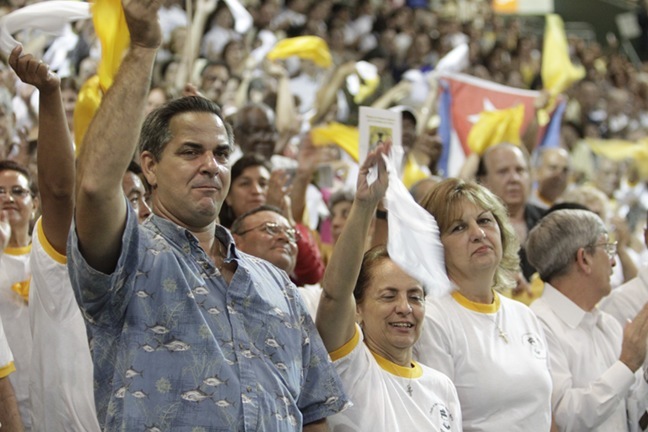By Ana Rodriguez Soto - Florida Catholic newspaper
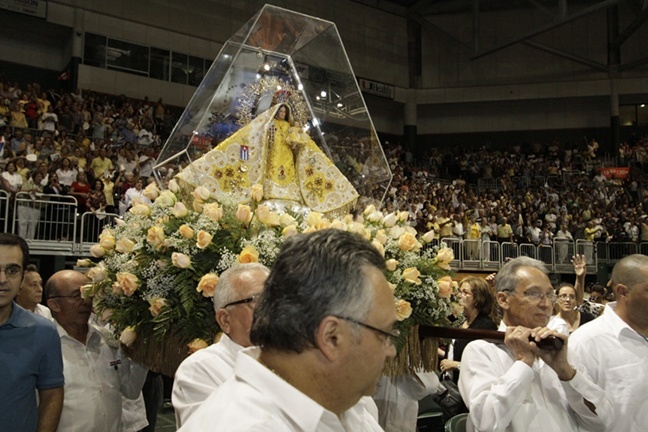
Photographer: ANA RODRIGUEZ-SOTO | FC
The image of Our Lady of Charity brought from Cuba 50 years ago processes around the BankUnited Center.
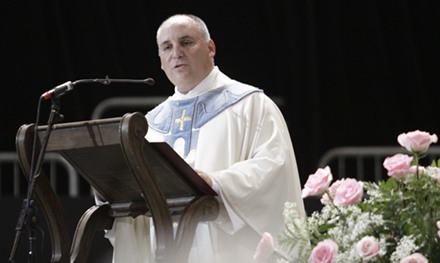
Photographer: ANA RODRIGUEZ-SOTO | FC
Father Rumin Dominguez, rector of the shrine, preaches the homily.
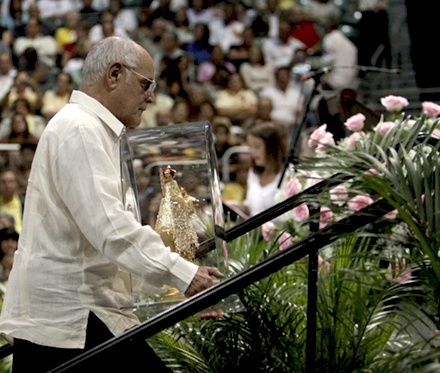
Photographer: ANA RODRIGUEZ-SOTO | FC
Luis Gutierrez, who smuggled the image of Our Lady of Charity out of Cuba 50 years ago, takes up another image of "cachita" as part of the offertory procession.
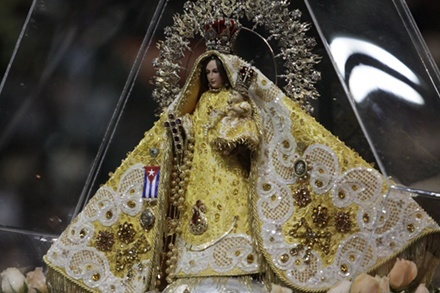
Photographer: ANA RODRIGUEZ-SOTO | FC
The image of Our Lady of Charity brought from Cuba 50 years ago processes around the BankUnited Center.
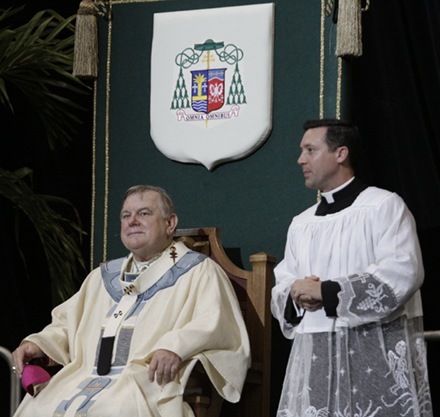
Photographer: ANA RODRIGUEZ-SOTO | FC
Archbishop Wenski and his master of ceremonies, Father Richard Vigoa, await the end of the Mass.
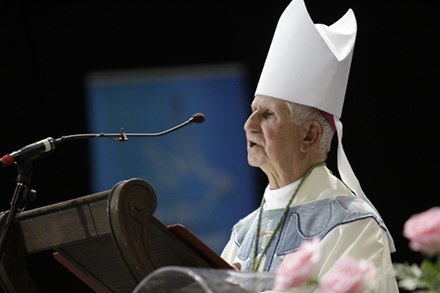
Photographer: ANA RODRIGUEZ-SOTO | FC
Bishop Roman tells one of his parable at the end of the Mass.
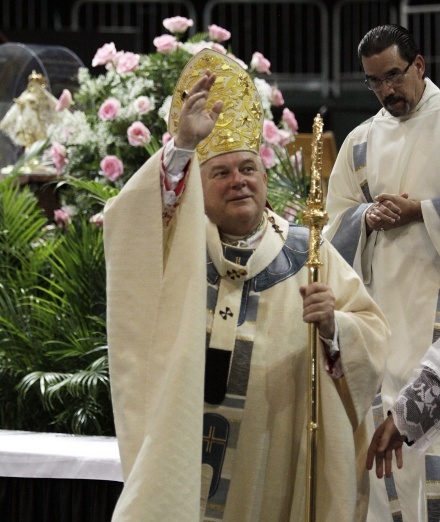
Photographer: ANA RODRIGUEZ-SOTO | FC
Archbishop Wenski blesses participants at the end of the Mass.
“Our mother had undertaken a journey to accompany her children in exile,” said Father Rumín Dominguez, rector of the National Shrine of Our Lady of Charity in Miami, who preached the homily during the Mass celebrated by Archbishop Thomas Wenski, various bishops and two dozen archdiocesan priests.
More than 5,000 people congregated in the Bank United Center on the University of Miami campus for the annual celebration of the feast of Our Lady of Charity, a tradition that began at the now defunct Bobby Maduro Stadium on Sept. 8, 1961.
Bishop Coleman Carroll, Miami’s first archbishop, had convoked Cuban exiles to the Mass, but no one expected too many people — perhaps 1,000. Instead, according to those who were there, 30,000 people filled the stadium.
“They were moved by love for God and for their heavenly mother. They were motivated by love for their country,” Father Dominguez said. “They came seeking the solace of faith for their pain.”
Then came the sign, the miracle that no one expected, the entrance of the image of Our Lady, a replica of the original which is found in El Cobre, which had just arrived that day. It was the image that Father Armando Jimenez Rebollar, pastor of the parish in Guanabo, had had sculpted 14 years earlier.
Luis Gutierrez, who had sought asylum six months earlier in the Panamanian embassy, brought the image to Miami in his luggage. It can be said that the image itself had sought asylum, for it had been hidden in the Italian embassy, awaiting a way out of Cuba.
“I was surprised when they gave her to me in the embassy,” recalled Gutierrez, who was unable to attend that first Mass. The first thing he did when he got to Miami was go to St. Patrick Church on Miami Beach to meet his newborn daughter — and witness her baptism.
He had been told that someone would be waiting at the airport to take the image but no one showed up. So he took her with him to St. Patrick and called the number he had been given by the embassy. That person picked up the statue and took it to the stadium.
“I didn’t go to that Mass but I have been to most of the others, and I have gone every Saturday to the shrine,” Gutierrez said.
This year, he participated in the Mass by taking another replica of the image of Our Lady of Charity up to the altar during the offertory procession.
“I never thought I would be here 50 years,” Gutierrez said.
Neither did the majority of Cubans who gathered for that first Mass. But their patroness stayed with them.
“She stayed here to protect and accompany her children, who continue to arrive,” said Father Dominguez. “And not only the Cubans. Here in exile, the virgin has become the mother of all. She embraces us all, without exception, under her mantle.”
“She is part of our most profound identity as Ibero-Americans,” Father Dominguez said. That is why, today, the National Shrine of Our Lady of Charity in Miami has become “the house of prayer for everyone.”
“Her presence kept alive the faith of her people,” he added.
Then he turned to the young people from archdiocesan schools who participated in the Mass, including a contingent of 100 from Belen Jesuit Prep, which is marking 50 years in exile as well. Father Dominguez told them: “You are the heirs and the continuation of that history of fidelity and commitment to God.”
Miami’s retired auxiliary bishop, Agustín Román, spoke at the end of Mass. He, too, was not present at that first Mass, because he had not yet been expelled from Cuba. But in 1967, one year after arriving in Miami, Bishop Carroll put him in charge of the construction of the shrine, and he has remained there for the past 44 years.
He told the congregation one of the parables he is well known for, recalling a lesson he learned as a 4 or 5-year-old child in Cuba:
One day, a milk cow swallowed a mango, and began to choke. The strongest men in the town tried unsuccessfully to take the mango out of the cow’s mouth. Finally, they created a metal ring and inserted it into the cow’s mouth. That is when his father, a peasant, called him over and told him to insert his hand inside the ring and pull out the mango.
“I took out the mango and saved the breakfast for the next day,” Bishop Román said. “A small hand was able to do much more than all those strong hands.”
In the same way, “what is small becomes large in the hands of God. What is large, sometimes, in our hands, becomes small,” the bishop continued.
With that lesson in mind, he put the work of building the shrine in the hands of God 44 years ago. “Don’t be frightened by the things you have to do. Put them in the hands of God and you won’t have any problem,” he said.
A proclamation from Archbishop Wenski also was read at the end of Mass, declaring the shrine a place of pilgrimage during the coming year, when Cubans on both sides of the Florida Straits will mark the 400th anniversary of the finding of their patroness in the Bay of Nipe.
That means a plenary indulgence will be granted to all who visit the shrine, provided they go to confession, receive Communion and pray for the intentions of Pope Benedict XVI.

